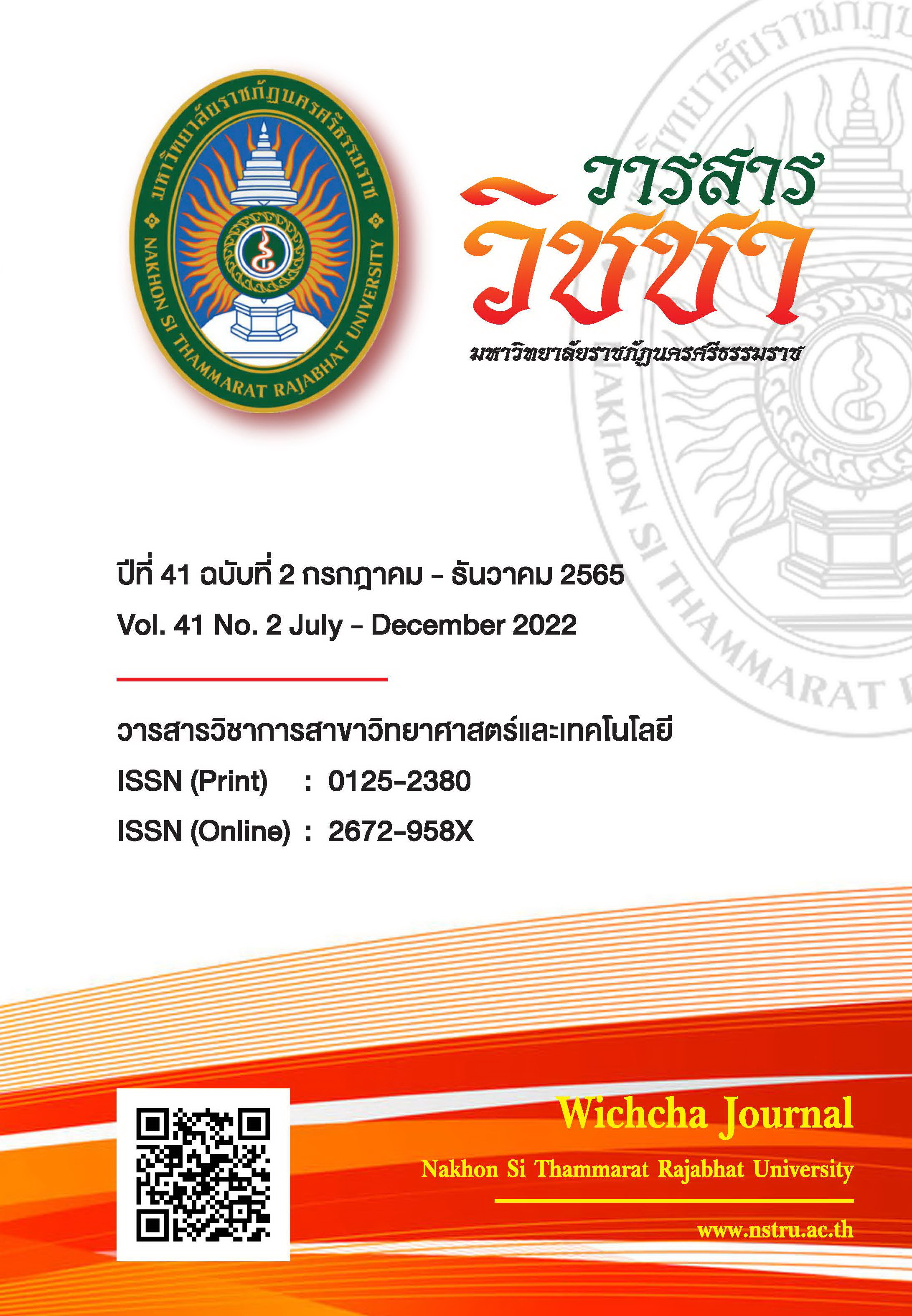Screening for Phosphate Solubilizing Bacteria Capable of Enhancing Rice Seedling Growth
Main Article Content
Abstract
Phosphorus is a plant nutrient essential for normal plant functions but in problematic soil, phosphorus becomes less available for plants use. Phosphate solubilizing bacteria can enable plants to use more soil phosphorus by changing it to available forms for plant absorption. In order to select for bacterial isolate with potential to enhance rice growth under low phosphorus, 10 isolates of phosphate solubilizing bacteria were selected and evaluated for their growth promoting abilities in rice cultivar KDML 105 grown by using rock phosphate as a phosphorus supplement. Bacteria were applied using 3 different methods, which were seed soaking, seed soaking with soil drenching, and soil drenching alone. Each experiment was arranged in CRD with 4 replications and plant growth parameters were collected at 14, 21 and 28 days after sowing. Results indicated that seed soaking with soil drenching elicited stronger growth enhancing response in shorter time, while soil drenching alone had no effect on seedling growth. Seedlings received isolate C13 performed best in all tested methods. Soaking rice seeds with isolate C13 resulted in increasing root fresh weight, total fresh weight, and total dry weight of 28 days old plants by 85.82, 57.77 and 49.19%, respectively. When given by seed soaking with soil drenching, it increased all parameters of fresh weight, dry weight, and plant length of 14 days old plants, especially root growth by more than 60%. This result suggests that both the method of bacterial applications and the type of phosphate solubilizing bacteria contribute to the effectiveness of a bacterium to enhance rice seedling growth.
Article Details

This work is licensed under a Creative Commons Attribution-NonCommercial-NoDerivatives 4.0 International License.
เนื้อหาและข้อมูลในบทความที่ลงตีพิมพ์ในวารสารวิชชา มหาวิทยาลัยราชภัฏนครศรีธรรมราช ถือเป็นข้อคิดเห็นและความรับผิดชอบของผู้เขียนบทความโดยตรง ซึ่งกองบรรณาธิการวารสารไม่จำเป็นต้องเห็นด้วยหรือร่วมรับผิดชอบใด ๆ
บทความ ข้อมูล เนื้อหา รูปภาพ ฯลฯ ที่ได้รับการตีพิมพ์ในวารสารวิชชา มหาวิทยาลัยราชภัฏนครศรีธรรมราช ถือเป็นลิขสิทธ์ของวารสารวิชชา มหาวิทยาลัยราชภัฏนครศรีธรรมราช หากบุคคลหรือหน่วยงานใดต้องการนำข้อมูลทั้งหมดหรือส่วนหนึ่งส่วนใดไปเผยแพร่ต่อหรือเพื่อการกระทำการใด ๆ จะต้องได้รับอนุญาตเป็นลายลักษณ์อักษรจากวารสารวิชชา มหาวิทยาลัยราชภัฏนครศรีธรรมราชก่อนเท่านั้น
The content and information in the article published in Wichcha journal Nakhon Si Thammarat Rajabhat University, It is the opinion and responsibility of the author of the article. The editorial journals do not need to agree. Or share any responsibility.
References
กฤชญา ปัญญา เนตรนภา อินสลุด และสายสมร ลำยอง. (2560). ผลของการใช้แบคทีเรียละลายฟอสเฟตในการส่งเสริมการเจริญเติบโตของข้าวในสภาพแอโรบิก. แก่นเกษตร, 45(1), 1093-1098.
เกตน์ณนิภา วันชัย และสมาพร เรืองสังฃ์. (2557). ผลของแบคทีเรียละลายฟอสเฟตที่ตรึงอยู่บนขี้เถ้าแกลบต่อการเจริญเติบโตของข้าวพันธุ์ กข47. วิทยาศาสตร์เกษตร, 45(2), 513-516.
ทศพร บ่อบัวทอง เนตรนภา อินสลุด วิชญ์ภาส สังพาลี และจุฑามาศ อาจนาเสียว. (2560). ผลของระดับฟอสฟอรัสต่อการพัฒนาระบบรากข้าว. แก่นเกษตร, 45(1), 997-1002.
เพชรดา ปินใจ ฉัตราภรณ์ ทองปนแก้ว และชนิดาภา ธนะศรีรางกูร. (2564). การศึกษาความเป็นประโยชน์ของฟอสฟอรัสและการส่งเสริมการเจริญเติบโตของอ้อยโดยแบคทีเรียละลายฟอสเฟตในสภาพโรงเรือนเพื่อการพัฒนาเป็นชีวภัณฑ์. วารสารเกษตรพระจอมเกล้า, 39(2), 109-118.
สำนักส่งเสริมการค้าสินค้าเกษตรและอุตสาหกรรม. (2564). ข้าว. สืบค้นเมื่อ 2 มิถุนายน 2565, จาก: https://www.ditp.go.th/contents_attach/750851/750851.pdf.
สุภาพร จันรุ่งเรือง เบญจมาส รสโสภา และกรรณิการ์ สัจจาพันธ์. (2553). ผลของแบคทีเรียละลายฟอสเฟต Burkholderia sp. สายพันธุ์ Rs01 ต่อการเจริญเติบโตของข้าวโพดหวานพันธุ์อินทรี 2. วิทยาสารกําแพงแสน, 8(1), 1-14.
อนุสรา พิศน้อย และอรวรรณ ฉัตรสีรุ้ง. (2562). การคัดกรองและการประเมินประสิทธิภาพของไรโซแบคทีเรีย เพื่อการส่งเสริมการเจริญเติบโตของต้นกล้าข้าว. วารสารเกษตร, 35(3), 461-473.
Alori, E.T., Glick, B.R. and Babalola, O.O. (2017). Microbial phosphorus solubilization and its potential for use in sustainable agriculture. Frontiers in Microbiology, 8, doi: https://doi.org/10.3389/fmicb.2017.00971.
Bakhshandeh, E., Rahimian, H., Pirdashti, H. and Nematzadeh, G.A. (2015). Evaluation of phosphate solubilizing bacteria on the growth and grain yield of rice (Oryza sativa L.) cropped in northern Iran. Journal of Applied Microbiology, 119(5), 1371-1382, doi: https://doi.org/10.1111/jam.12938.
Banik, A., Dash, G.K., Swain, P., Kumar, U., Mukhopadhyay, S.K. and Dangar, T.K. (2019). Application of rice (Oryza sativa L.) root endophytic diazotrophic Azotobacter sp. strain Avi2 (MCC 3432) can increase rice yield under green house and field condition. Microbiological Research, 219, 56-65, doi: https://doi.org/10.1016/j.micres.2018.11.004.
Bünemann, E.K. (2015). Assessment of gross and net mineralization rates of soil organic phosphorus-A review. Soil Biology and Biochemistry, 89, 82-98, doi: https://doi.org/10.1016/j.soilbio.2015.06.026.
Chen, Q. and Liu, S. (2019). Identification and characterization of the phosphate-solubilizing bacterium Pantoea sp. S32 in reclamation soil in Shanxi, China. Frontiers in microbiology, 10, doi: https://doi.org/10.3389/fmicb.2019.02171.
Elhaissoufi, W., Khourchi, S., Ibnyasser, A., Ghoulam, C., Rchiad, Z., Zeroual, Y., Lyamlouli, K. and Bargaz, A. (2020). Phosphate solubilizing rhizobacteria could have a stronger influence on wheat root traits and aboveground physiology than rhizosphere P solubilization. Frontiers in Plant Science, 11, doi: https://doi.org/10.3389/fpls.2020.00979.
Glick, B.R. (2012). Plant growth-promoting bacteria: Mechanisms and applications. Scientifica, 2012, doi: https://doi.org/10.6064/2012/963401.
Heuer, S., Gaxiola, R., Schilling, R., Herrera-Estrella, L., López-Arredondo, D., Wissuwa, M., Delhaize, E. and Rouached, H. (2017). Improving phosphorus use efficiency: A complex trait with emerging opportunities. The Plant Journal, 90(5), 868-885, doi: https://doi.org/1010.1111/tpj.13423.
Insalud, N., Bell, R.W., Colmer, T.D. and Rerkasem, B. (2006). Morphological and physiological responses of rice (Oryza sativa) to limited phosphorus supply in aerated and stagnant solution culture. Annals of Botany, 98(5), 995-1004, doi: https://doi.org/10.1093/aob/mcl194.
Lindsay, W.L., Vlek, P.L. and Chien, S.H. (1989). Phosphate minerals. In Dixon, J.B. and Weed, S.B. (Eds.). Minerals in Soil Environment, pp. 1089-1130. Wisconsin: Soil Science Society of America Inc.


